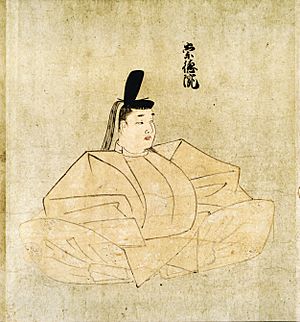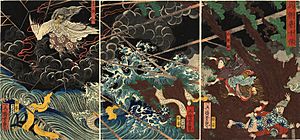Emperor Sutoku facts for kids
Quick facts for kids Emperor Sutoku崇徳天皇 |
|||||
|---|---|---|---|---|---|

Portrait of Emperor Sutoku by Fujiwara Tamenobu, 14th century
|
|||||
| Emperor of Japan | |||||
| Reign | February 25, 1123 – January 5, 1142 | ||||
| Coronation | March 18, 1123 | ||||
| Predecessor | Toba | ||||
| Successor | Konoe | ||||
| Born | July 7, 1119 | ||||
| Died | September 14, 1164 (aged 45) | ||||
| Burial | Shiramine no misasagi (白峯陵) (Kagawa) | ||||
| Spouse | Fujiwara no Kiyoko | ||||
| Issue | Prince Shigehito | ||||
|
|||||
| House | Yamato | ||||
| Father | Emperor Toba | ||||
| Mother | Fujiwara no Tamako | ||||
Emperor Sutoku (born July 7, 1119 – died September 14, 1164) was the 75th Emperor of Japan. He ruled Japan from 1123 to 1142. His personal name was Akihito.
Contents
Who Was Emperor Sutoku?
Emperor Sutoku was the eldest son of Emperor Toba. Some old stories say he might have been the son of Toba's grandfather, Emperor Shirakawa.
Emperor Sutoku's Family
- Empress: Fujiwara no Kiyoko (later known as Kōkamon'in). She was the daughter of Fujiwara no Tadamichi.
- Son: Imperial Prince Shigehito (1140–1162). His mother was Hyounosuke-no-Tsubone.
- Another Son: Kakue (1151-1184). His mother was Mikawa-dono.
Key Events in Emperor Sutoku's Life
Let's look at some important things that happened during Emperor Sutoku's time.
- 1123: When Emperor Sutoku was just 3 years old, his father, Emperor Toba, stepped down from the throne. Sutoku then became the new emperor. This is called accession to the throne.
- 1124: Former Emperors Shirakawa and Toba, along with many court ladies, went on a fun outing to see flowers. It was a very colorful parade!
- 1125: The young Emperor Sutoku visited many important Shinto shrines. These included Iwashimizu Shrine and the Kamo Shrines.
- 1128: Sutoku's mother, Taiken-mon'in, ordered a special temple called Enshō-ji to be built. This was one of several "sacred vow temples" built by emperors.
- 1128: Fujiwara no Tadamichi, a powerful leader, changed his role. He stopped being a sesshō (a regent who rules for a young emperor) and became a kampaku (another important advisor).
- 1135: Former-Emperor Shirakawa, Sutoku's grandfather, passed away at age 77.
- 1141: Former-Emperor Toba, Sutoku's father, became a Buddhist monk at age 39. This means he left his royal life to focus on religious practices.
In 1151, Emperor Sutoku asked for a collection of Japanese poems called Shika Wakashū to be created.
In 1156, there was a big fight called the Hōgen Rebellion. Emperor Sutoku lost this fight and was sent away from the capital. He was exiled to Sanuki Province (which is now Kagawa Prefecture on the island of Shikoku).
Emperor Sutoku ruled for 19 years. His reign included several different era names, or nengō.
The place where Emperor Sutoku is buried is called Shiramine no misasagi. It is a special Shinto shrine and mausoleum in Sakaide, Kagawa. He is also honored at Shiramine shrine in Kyoto and Kotohira-gū in Kagawa Prefecture.
Important Court Officials (Kugyō)
The Kugyō (公卿) were a small group of the most powerful men in the Japanese court before the Meiji period. These men usually inherited their positions and had a lot of experience.
During Emperor Sutoku's reign, some of these top officials included:
- Sesshō (Regent): Fujiwara no Tadamichi
- Daijō-daijin (Chancellor of the Realm): Fujiwara no Tadamichi
- Nadaijin (Minister of the Center): Fujiwara no Yorinaga
Eras During Sutoku's Reign
Japanese emperors' reigns are divided into different time periods called nengō or eras. Here are the eras during Emperor Sutoku's rule:
- Hōan (1120–1124)
- Tenji (1124–1126)
- Daiji (1126–1131)
- Tenshō (1131–1132)
- Chōshō (1132–1135)
- Hōen (1135–1141)
- Eiji (1141–1142)
Legends of Emperor Sutoku
After Emperor Sutoku was sent away, he became a monk. He copied many Buddhist scriptures and sent them to the court. But the court refused to accept them, fearing they were cursed.
Because of this, it is said that Sutoku became very angry and, after he died, turned into a powerful vengeful spirit (called an onryō in Japanese). People believed that all the bad things that happened later, like the decline of the Imperial court, the rise of the samurai, droughts, and unrest, were caused by his haunting.
Emperor Sutoku is often called one of the “Three Great Onryō of Japan” along with Sugawara no Michizane and Taira no Masakado.
Stories and art from later periods, like the Edo period, show Emperor Sutoku as an onryō. For example, the book Ugetsu Monogatari and paintings by Utagawa Yoshitsuya depict him this way.
In 2023, a heavy metal band called Onmyo-Za even made a song about Emperor Sutoku as an onryō, called Shiramine.
See also
 In Spanish: Sutoku Tennō para niños
In Spanish: Sutoku Tennō para niños
- Shin Heike Monogatari, (Taiga Drama), Masakazu Tamura played Emperor Sutoku.
- Emperor of Japan
- List of Emperors of Japan
- Imperial cult
- Goryō



